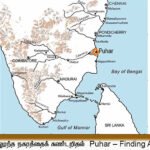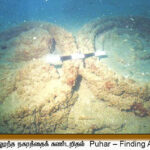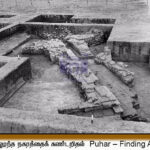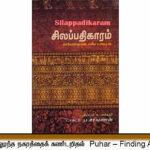

Puhar – Finding A Lost City
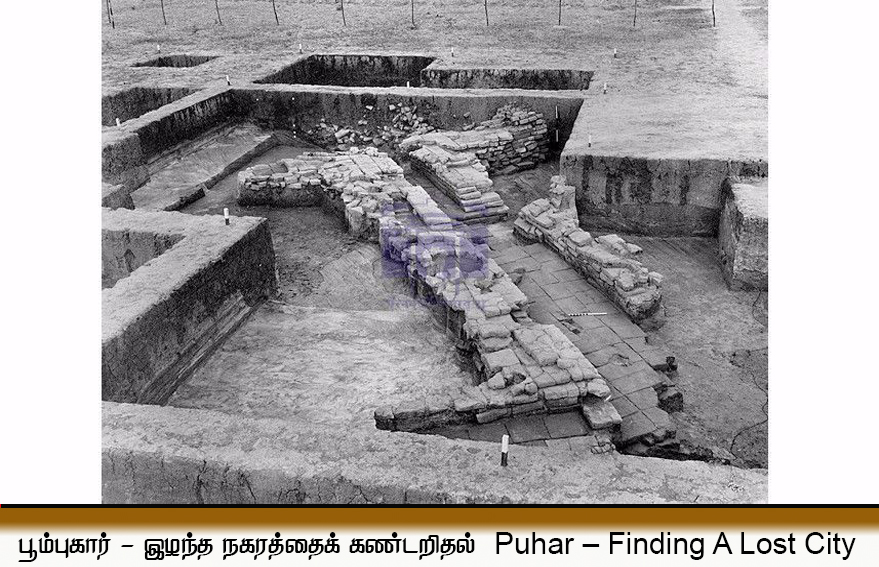
Facts are sometimes stranger than fiction. Imagine a vanished city, frequently referred to in ancient literature, myths and legends as one that was ‘swallowed up by the sea’, resurfacing under the lens of archaeologists. Excavations have unearthed remnants of the great port city of Poompuhar, destroyed by a deadly tsunami, hundreds of years ago.
Till even a hundred years ago any connection between the sleepy little town of Puhar in the Nagapattinam District of Tamil Nadu and the exotic city of Poompuhar (Puhar) described in the great Sangam era epics was brushed aside as a flight of fancy. Today, after many rounds of painstaking excavations, historians are slowly piecing together the connections and marking out the lines between legend and history, as the story of this 2000-year-old port comes alive.
Once a great port city of Poompuhar was destroyed by a tsunami hundreds of years ago
The earliest reference to Puhar can be found in the old Sangam era epics as well as the Periplus of the Erythraean Sea, the travelogue by an anonymous merchant, penned during the 1st century CE. Referred to as a major port city of the Early Chola Kingdom, on the mouth of the Kaveri river – where it meets the Bay of Bengal, it was known by various names Puhar, Poompuhar, Kaveripoompattinam and Kaveripattinam through time.
Tamil epic, Silappadikaram
The Silappadikaram, a poetic work by the author Ilango Adigal, revolves around Kannagi, a woman who loses her husband because of the a miscarriage of justice at the court of the Pandyan king. Devastated and angry Kannagi extracts her revenge on his kingdom. The story is set in the city of Puhar and provides great details about the city. It talks about the city layout and how it was divided into two parts – Maruvurpakkam where the working class and foreign (Yavanas) merchants lived and Pattiinappakkam to its west where the king and the nobles lived. The epic talks about the great terraced mansions of Puhar, granaries and warehouses with windows shaped like ‘the eyes of the deer’ and a big ship-yard.
The city of Puhar was considered as a myth as the epic Silappadikaram mentions that the city was ‘swallowed up by the sea’
The author of the Silappadikaram ‘refers to Poompuhar (Puhar) as a Mahanagaram, a great city and a bustling port where ‘horses were brought by the ships; sacks of pepper were brought by carts; gemstones and gold came from the northern mountains; pearls from the southern seas and wheat came from the Gangetic region.’
The Periplus of the Erythraean Sea a work by a merchant, composed during the 1st century CE has provided a brief on the Chola kingdom and its towns, ports and trade centers. Ptolemy, the Greek geographer from the 2nd century CE describes the city of Puhar as well-planned, in his work Geographia.
Excavation of the brick Wharf | National Institute of Oceanography, India
But after the many early references to this great port – there is a big gap. The city of Puhar – simply disappears. The epic Silappadikaram also has a vivid description of the ‘end’ of Puhar. According to the epic it was – ‘swallowed up by the sea’ as the king had lost his son and in a grip of grief forgot to celebrate the Indra Vizha (Annual festival for the rain God Indra).’
Given the ‘disappearance’ of Puhar from all records, after the early Sangam era it seems to have got lost in time, merging into legend and myths. The city disappeared so completely that the fact that it ever existed was questioned. But excavations in the region indicate that there might have been a major natural calamity, probably a tsunami, that wiped out the port of Puhar around the 3rd century CE.
While exploring that area archaeologists found the remains of the ancient port
Studies by geologists and marine archaeologists have ratified this claim. In 1910’s a team of archaeologists found the remains of a wharf and rediscovered this ancient port while exploring the area. In the subsequent years, other wharfs made of burned bricks were discovered and dated from 3rd century BCE to 3rd century CE. The wharf had a brick structure with a drain, for the flow of water and a platform supported by wooden posts for handling cargo, this was built on the channel of the Kaveri river. Archaeologists also discovered a semicircular brick structure, probably of a reservoir during excavations.
The under-water archaeological excavations around the modern Puhar region continued through the decades. The archaeological exploration by the team led by KV Sondurajan from 1971-74 at Kilaiyur, close to Puhar, also yielded square copper coins with the tiger emblem. This was the royal crest of the early Cholas. Other finds include beads of semi-precious stones and pieces of amphorae, a typical roman pottery.
In 1981, a joint team of the Department of Archaeology, Tamil Nadu and National Institute of Oceanography (NIO), Goa led by AS Gaur conducted an under-water excavation offshore survey of Tranquebar, 5 km south of Puhar, to locate a shipwreck. The underwater excavations led to the discovery of stone structures suggestive of an ancient port and temples, which were buried about 30 feet in the sea. This the team concluded – was the ancient city of Puhar.
Though the remains of the port have been found in archaeological excavations we have to rely on literary sources to understand what life was like there.
Historian Dr Radhika Seshan, from the Savitribai Phule University, who has studied maritime trade in the region believes that there is no doubt the Puhar was an ancient city. She says –
‘The port of Poompuhar definitely goes back to what is called the ‘Sangam’ period – i.e. approximately from the 4th century BCE. It continued to be occupied till the 3rd century CE, and possibly even after that. One of the problems of the history of south India is that for the period late 3rd century CE to 5th century CE, there are no sources at all.’
The region of Puhar was once again occupied in the 6th century CE under the Pallavas of Tondaimandalam. The region of ancient port of Puhar came to be known as Kaveripattanam.
The region of Puhar was again occupied and came to be known as Kaveripattanam
The Tamil poem Manimekalai dated to 6th century CE is set in the town of Kaveripattanam (Puhar) and it describes the Buddhist monasteries and monks living in the area during the Pallava period. Archaeological excavations in the adjoining village of Pallavanesvaram have unearthed the remains of a Buddhist monastery and a Buddha statue dating between 4th and 5th century CE.
Radhika Seshan says that the port of Puhar declined with the fall of the early Cholas. As the Pallavas took charge, trade shifted north, to their port city in Mamallapuram, i.e. Mahabalipuram. The region was later occupied and revived under the later Cholas, who named it it Kaveripattinam. But by now this old port city was a shadow of itself. Nagapattinam 50 kms away from Puhar emerged as an important port and trading center by early 11th century CE and continued to prosper under the rule of Imperial Cholas till the 14th century.
Kaveripattinam (Puhar) was once again eclipsed, this time by the port of Nagapattinam.
The story of what the city of Puhar was like and how badly it was destroyed is gradually being pieced together as teams excavate and dive deep into the waters of the Bay of Bengal. But what the story of Puhar tells us is that there is often a kernel of truth in legends … and while there may not be a physical reference to the great port city of Puhar, the city remains frozen in time in the great epics and so the collective memory of the people of the region.
